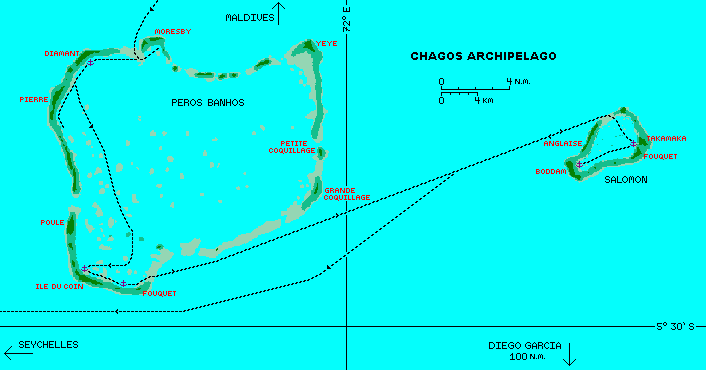
Map of our anchorages in the Chagos Archipelago
Indian Landfalls Chagos Pages UpRelated Pages Chagos NewslettersChagos Cruising Info |
Chagos
 Map of our anchorages in the Chagos Archipelago |
Language: English, as the islands are a British Indian Ocean Territory.
Population: No permanent residents except the US military base
on Diego Garcia which is off-limits to visiting yachts. A transient yachting
community fluctuates from a few to over 50 international yachts at Peros Banhos
and Salomon Atolls.
Money: In the yachting community, none, but Chagos "currency"
includes fish, dinghy fuel and fresh veggies.
Landscape: 99.9% water. Fantastic coral and fish life both in the lagoons and
outside the low sandy atolls.
Visited: 20 April to 28 June, 2007
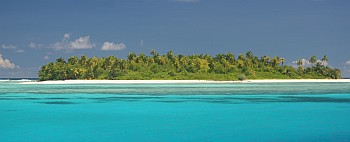 Blue skies, blue water. Classic Chagos. |
History: Despite being only 300 miles south of the Maldives, the Chagos Archipelago (which stretches for almost 200 miles north to south) was never settled by any of the sea-faring nations like its neighbors to the north (the Maldives) and west (Seychelles, Reunion and Mauritius). The first European to sight the islands was Vasco da Gama in the early 16th century and indeed some of the original Portuguese names such as Peros Banhos and Diego Garcia remain in use. Under French rule, in 1783, a land concession was granted allowing the islands to be used as plantations for the production of coconut oil. The first was on Diego Garcia, the southern-most and largest of the islands, and slave labor was brought from Mozambique and Madagascar to work the plantations. In later years both indentured, free and slave labor was brought in to the northern atolls of Salomon and Peros Banhos. These people became known as Ilois, their own French Creole word for islanders. Fish, guano and tortoises were also harvested in addition to coconuts.
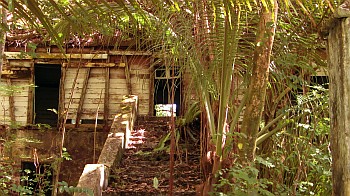 Reclaimed by the island: the old manager's house |
Chagos became part of Britain after the defeat of Napoleon in 1814, and was administered from the Seychelles. With emancipation in 1835, many families of freed slaves stayed to work the copra plantations. Indentured workers from India were brought to the islands in the 1840's and 1850's. Many of the residents converted to Christianity. Self-sustaining communities with fruit trees, well water, livestock, vegetable gardens, hospitals and churches continued into the mid-20th century and the population on 3 or 4 atolls swelled to near 2,000. For a short time Diego Garcia was used as a coaling station for trans-Indian ocean steamers, but when that collapsed, the islands returned to obscurity.
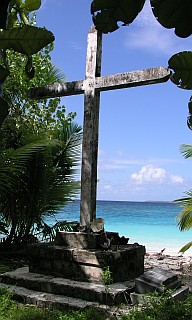 Old cross on Boddam Island |
It was during the Cold War of the 1960's that the US became interested in having a military presence in the southern Indian Ocean. They negotiated with Britain, who administered Chagos as British Indian Ocean Territory (BIOT), for a base on Diego Garcia - with the proviso that there be no inhabitants anywhere in Chagos. Britain agreed, the copra industries were closed, and from 1968 to 1973 over 2,000 people were transported against their wishes to live on the newly independent island of Mauritius. Today fewer than 700 are still alive and most live in poverty. Activists among the surviving Chagossians have challenged the British Government and have won through the High Court the right to return to the islands. A see-sawing of appeals and court rulings have resulted in little more than frustration, anger and expense for all involved. Something might have come of these rulings if it weren't for onset of the war against terrorism as a result of the attacks of September 11, 2001. The US now rigorously adheres to the policy of isolation, and BIOT continues to monitor both yachting and fishing activity in the islands.
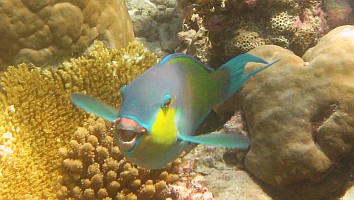 A very curious Palenose Parrotfish. Amanda Hacking |
It wasn't until we arrived that we learned the history of the Chagossian people and their struggle to return to the islands. It is a complicated issue, and one on which few of us felt qualified to comment.
(Sue) Within a few hours of arriving in Chagos we commented to each other, and to other cruisers, that this is the kind of place we sail around the world hoping to find. It is absolutely BEAUTIFUL. The air is the clearest in the world and the snorkeling truly magical, with colorful fish in abundance, huge coral formations, and the occasional shark to spice things up. On shore the lush vegetation of Scaveola bushes, Takamaka hardwood trees and the omnipresent coconut palms make nesting places for red-footed boobies and terns. Amongst the trees live a huge population of indigenous coconut crabs, non-indigenous rats (who don't hassle the yachties) and an occasional wild chicken.
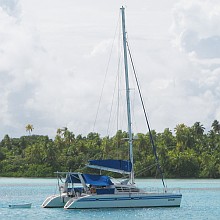 Ocelot at Takamaka anchorage |
This was our first prolonged visit to an uninhabited tropical atoll and we fell in love with it. Those who loved fishing could take the dinghy to the outer reef and be almost guaranteed of a meal-sized catch of yellow fin or skip-jack tuna, grouper, mackerel or even dorado. Line fishing from the boat inside the lagoon yielded grouper and squid. We ate fish for 45 of our 63 days in Chagos. Amanda and I spent many hours in the water snorkeling and photographing the corals and fish.
There is, surprisingly, a great deal of personal freedom when one's choices are limited and Chagos personified that for me. I liked the isolation, the knowledge that we were self-sufficient and had all the food we needed right there on Ocelot or in the ocean. I loved getting up each day to decide what we as a family would do, with no external dictates as to day of the week, business hours, etc. To take the small dinghy and row over aqua clear waters in which I could see individual fish, then pull it up onto a powdery white sand beach to photograph the noddies and terns or explore the tide pools for pepper eels or living mollusks -- that's my idea of paradise.
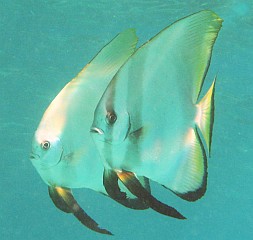 Circular spadefish lived under Ocelot |
(Jon) Chagos is indeed the kind of place one thinks of when you say the words "tropical paradise." Two atolls of small islands surrounding central lagoons, and no permanent inhabitants anywhere. Long sand beaches on the shore, and tall coconut palms waving in the soft tropical breezes just inland. Lots of vibrant coral to explore in the lagoons, teeming with exotic fish. The ruins of the 2 copra operations can be found on Coin and Boddam for those wishing to bush-whack through the jungle. Surprisingly, such tropical paradises are extremely rare, so we really appreciated being at Chagos.
 Jon in Tomcat, off Ile de Coin |
Getting to Chagos is difficult enough that only genuine, blue-water cruising boats can manage it, so there's lots of camaraderie between the boats. Being almost exactly in the middle of the Indian Ocean, boats can arrive from many directions - from SE Asia, the Indian sub-continent, Africa, the Mediterranean, or even directly from Australia. This makes a pretty eclectic mix, with cruisers having lots of different stories and backgrounds - fertile ground for meeting interesting new people, learning about future cruising destinations (someone's likely just come from there) and making new friends.
I remember lots of great get-togethers, usually over interesting meals originating from all over the the world, Amanda and her friends doing Polynesian dancing on the beach against the setting sun, long walks around the islands at low tide, drift snorkeling through the Fouquet-Takamaka pass, going with friends in our dinghy to explore and picnic on other islands, examining the piles of interesting bright shells that the octopi would pile up as gardens on some of the big fan corals, fishing with friends on the outer reefs and catching some nice big tuna to share with others, watching the spinner dolphin leaping out of the water and spinning around in the air before splashing into the ocean, only to do it again a few moments later, and generally exploring as much of this paradise as I could.
 Walking the beach, Ile Fouquet, Peros Banhos |
(Amanda) My goodness, what a beautiful place. And so isolated, and pristine, and just magnificent. Words cannot do it justice, but I guess I'll have to try. What I enjoyed most about our Chagos experience was being one of only two boats in all of Peros Banhos for a week, the other being our cruising buddies Estrela. All we had to think about was what to do right now. Shall we snorkel this reef today? Or maybe that reef? Let's study corals. Let's see if we can swim with dolphins. How about a beach walk? Or a walk around the perimeter of that island? Maybe take the dinghy outside the pass for a quick bit of fishing. Sailing-dinghy race! Come on over for a potluck tonight. Bring your guitar, let's sing the night away! Pizza cooking class, anyone? How about a movie night?
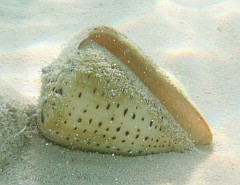 Live cone shell in Chagos sand |
This isolation finally ended when the wind changed and we had to seek shelter from easterlies in Salomon Atoll. There was a slightly different feel to the 'cruising community' in Salomon, but it was still lots of fun. Every afternoon there was volleyball on the beach, followed by sundowners and maybe a potluck. Most mornings several people would take their dinghies outside the reef to fish. In other words, life was a bit more structured. Which was okay in small doses, but I didn't come to paradise to have my life dictated by time and 'traditions'. So we avoided most of that by anchoring on the more-pleasant sand bank between Iles Fouquet and Takamaka. There was good snorkeling just ahead of the boat when the tide was right, and every day I'd photograph the terns and noddies sitting on our bow and flying around the boat.
The atoll slowly emptied out, as people sailed off for Seychelles or Maldives and Malaysia. Unable to bear the thought of leaving before we had to, we extended our stay for a month. We just didn't want to leave! But our departure date got nearer and nearer, and when a weather window came, we reluctantly took it. There were only three boats left as we gave our farewell message over the radio and sailed off for the Seychelles.
Top Level: Home | Destinations | Cruising Info | Underwater | Boat Guests | Ocelot | Sue | Jon | Amanda | Chris | Site Map | Make a Comment
|
If our information is useful, you can help by making a donation |
Copyright © 2000‑ Contact: Jon and Sue Hacking -- HackingFamily.com, svOcelot.com. All rights reserved.